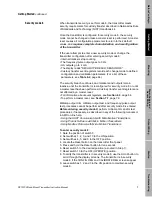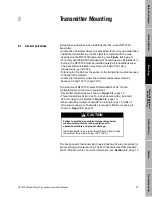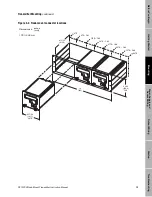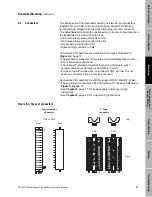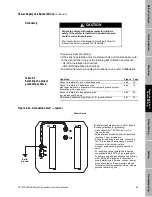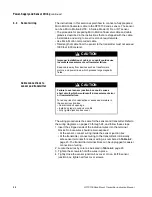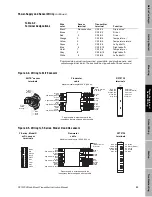
Getting Started
continued
RFT9739 Rack-Mount Transmitter Instruction Manual
9
O
u
tp
ut Wi
ri
ng
Star
tu
p
T
ro
u
b
le
s
hoo
ting
Be
fo
re
Y
o
u
B
e
g
in
Getti
ng Sta
rted
M
oun
ting
P
o
w
e
r-
Suppl
y and
Sen
s
or Wi
ri
ng
Communication settings
Switch 5 enables the user to choose the standard communication
configuration or user-defined parameters. With switch 10 in the ON
(CONFIG) position, switches 1 through 6 can be used for setting user-
defined communication parameters.
Standard communication setting
To use the standard communication configuration, set switch 5 to the
STD COMM position. Setting the switch in this position establishes the
following parameters:
• HART protocol on the Bell 202 standard, at 1200 baud, on the primary
mA output
• Modbus protocol in RTU mode, at 9600 baud, on the RS-485 output
• 1 stop bit, odd parity
For RFT9739 software versions 3.6 and later, if switch 5 is in the STD
COMM position, an error message will appear on the RFT9739 display
when an attempt is made to change the communication configuration
using the RFT9739 display controls.
User-defined communication settings
To establish user-defined settings, set switch 5 to the USER-DEFINED
position, then use the buttons on the front panel to set baud rate; stop
bits and parity; data bits, protocol, and physical layer.
• When the transmitter is shipped from the factory, the default settings
are HART protocol, over RS-485, at 1200 baud, with 1 stop bit and odd
parity.
• For more information on using the display, see Section 6.2, page 60.
Milliamp output scaling
Switches 7, 8, and 9 allow the user to choose 0-20 mA or 4-20 mA
scaling for mA outputs, and upscale or downscale fault outputs.
Switch 7 defines the primary mA output scaling. Switch 8 defines the
secondary mA output scaling. Either switch may be set in the 0-20
position or the 4-20 position.
• The mA outputs are NAMUR compliant when switches 7 and 8 are in
the 4-20 position. See Section 5.3, page 27.
• Communication using the HART protocol over the primary mA output
requires switch 7 to be set in the 4-20 position.
• If switch 7 is in the 0-20 mA position, communication may be lost if
output is less than 2 mA. To re-establish communication, move switch 7
to the 4-20 mA position.
Switch 9 defines the RFT9739 fault outputs. Fault outputs can be set for
downscale or upscale levels.
• If switch 9 is set to the DWNSCALE position, mA outputs go to 0 mA if
they produce a 0-20 mA current, or to 0-2 mA if they produce a
4-20 mA current; the frequency/pulse output goes to 0 Hz.
• If switch 9 is set to the UPSCALE position, mA outputs go to 22-24 mA;
the frequency/pulse output goes to 15-19 kHz.
• For more information, see "Fault outputs", page 69.
Summary of Contents for Fisher Rosemount RFT9739
Page 1: ...Model RFT9739 Rack Mount Transmitter Instruction Manual Version 3 Transmitters February 2000 ...
Page 2: ......
Page 4: ......
Page 20: ...10 RFT9739 Rack Mount Transmitter Instruction Manual ...
Page 26: ...16 RFT9739 Rack Mount Transmitter Instruction Manual ...
Page 92: ...82 RFT9739 Rack Mount Transmitter Instruction Manual ...
Page 100: ...90 RFT9739 Rack Mount Transmitter Instruction Manual ...
Page 110: ...100 RFT9739 Rack Mount Transmitter Instruction Manual ...
Page 112: ...102 RFT9739 Rack Mount Transmitter Instruction Manual ...
Page 120: ...110 RFT9739 Rack Mount Transmitter Instruction Manual ...
Page 122: ...112 RFT9739 Rack Mount Transmitter Instruction Manual ...
Page 129: ......













